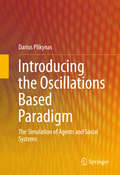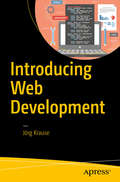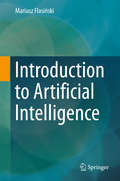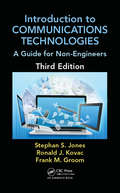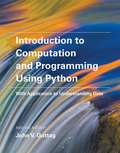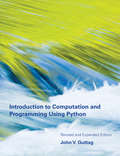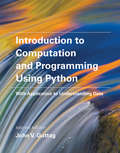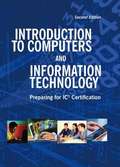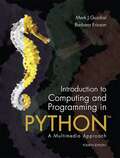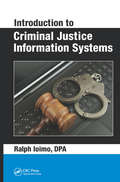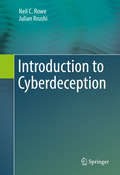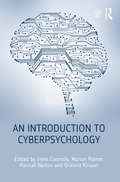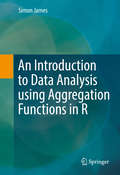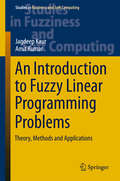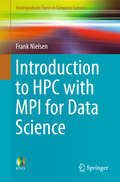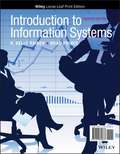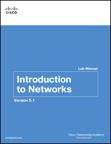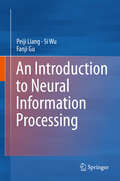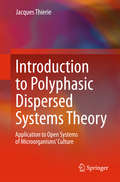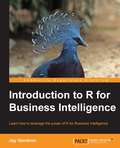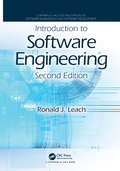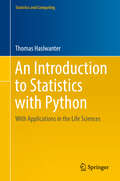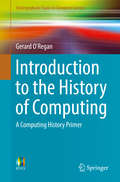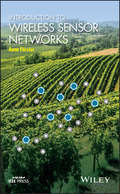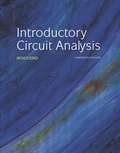- Table View
- List View
Introducing the Oscillations Based Paradigm
by Darius PlikynasThe book presents a conceptually novel oscillations based paradigm, the Oscillation-Based Multi-Agent System (OSIMAS), aimed at the modelling of agents and their systems as coherent, stylized, neurodynamic processes. This paradigm links emerging research domains via coherent neurodynamic oscillation based representations of the individual human mind and society (as a coherent collective mind) states. Thus, this multidisciplinary paradigm delivers an empirical and simulation research framework that provides a new way of modelling the complex dynamics of individual and collective mind states. This book addresses a conceptual problem - the lack of a multidisciplinary, connecting paradigm, which could link fragmented research in the fields of neuroscience, artificial intelligence (AI), multi-agent system (MAS) and the social network domains. The need for a common multidisciplinary research framework essentially arises because these fields share a common object of investigation and simulation, i. e. , individual and collective human behavior. Although the fields of research mentioned above all approach this from different perspectives, their common object of investigation unites them. By putting the various pathways of research as they are interrelated into perspective, this book provides a philosophical underpinning, experimental background and modelling tools that the author anticipates will reveal new frontiers in multidisciplinary research. Fundamental investigation of the implicit oscillatory nature of agents' mind states and social mediums in general can reveal some new ways of understanding the periodic and nonperiodic fluctuations taking place in real life. For example, via agent states-related diffusion properties, we could investigate complex economic phenomena like the spread of stock market crashes, currency crises, speculative oscillations (bubbles and crashes), social unrest, recessionary effects, sovereign defaults, etc. All these effects are closely associated with social fragility, which follows and is affected by cycles such as production, political, business and financial. Thus, the multidisciplinary OSIMAS paradigm can yield new knowledge and research perspectives, allowing for a better understanding of social agents and their social organization principles.
Introducing Web Development
by Jörg KrauseThis brief book is an easy-to-digest introduction to the key concepts of web development. Understand the concepts of the web and how they apply to static and dynamic websites. See how HTML and CSS are used to create the bones of the web. Concisely presented through four key concept chapters, Introducing Web Development will enable you to get a clear understanding of how web development works. What You Will LearnHow the web works and interacts with websitesWhat static and dynamic websites are and how they work How the static parts of a website are coded using HTML and CSSWho This Book Is ForAnyone who wants to understand the basics of web development.
Introduction to Artificial Intelligence
by Mariusz FlasińskiIn the chapters in Part I of this textbook the author introduces the fundamental ideas of artificial intelligence and computational intelligence. In Part II he explains key AI methods such as search, evolutionary computing, logic-based reasoning, knowledge representation, rule-based systems, pattern recognition, neural networks, and cognitive architectures. Finally, in Part III, he expands the context to discuss theories of intelligence in philosophy and psychology, key applications of AI systems, and the likely future of artificial intelligence. A key feature of the author's approach is historical and biographical footnotes, stressing the multidisciplinary character of the field and its pioneers. The book is appropriate for advanced undergraduate and graduate courses in computer science, engineering, and other applied sciences, and the appendices offer short formal, mathematical models and notes to support the reader.
Introduction to Communications Technologies: A Guide for Non-Engineers, Third Edition
by Stephan Jones Ronald J. Kovac Frank M. GroomThanks to the advancement of faster processors within communication devices, there has been a rapid change in how information is modulated, multiplexed, managed, and moved. While formulas and functions are critical in creating the granular components and operations of individual technologies, understanding the applications and their purposes in the
Introduction to Computation and Programming Using Python: With Application to Understanding Data
by John V. GuttagThis book introduces students with little or no prior programming experience to the art of computational problem solving using Python and various Python libraries, including PyLab. It provides students with skills that will enable them to make productive use of computational techniques, including some of the tools and techniques of data science for using computation to model and interpret data. The book is based on an MIT course (which became the most popular course offered through MIT's OpenCourseWare) and was developed for use not only in a conventional classroom but in in a massive open online course (MOOC). This new edition has been updated for Python 3, reorganized to make it easier to use for courses that cover only a subset of the material, and offers additional material including five new chapters.Students are introduced to Python and the basics of programming in the context of such computational concepts and techniques as exhaustive enumeration, bisection search, and efficient approximation algorithms. Although it covers such traditional topics as computational complexity and simple algorithms, the book focuses on a wide range of topics not found in most introductory texts, including information visualization, simulations to model randomness, computational techniques to understand data, and statistical techniques that inform (and misinform) as well as two related but relatively advanced topics: optimization problems and dynamic programming. This edition offers expanded material on statistics and machine learning and new chapters on Frequentist and Bayesian statistics.
Introduction to Computation and Programming Using Python, revised and expanded edition: With Application To Understanding Data
by John V. GuttagAn introductory text that teaches students the art of computational problem solving, covering topics that range from simple algorithms to information visualization.This book introduces students with little or no prior programming experience to the art of computational problem solving using Python and various Python libraries, including PyLab. It provides students with skills that will enable them to make productive use of computational techniques, including some of the tools and techniques of “data science” for using computation to model and interpret data. The book is based on an MIT course (which became the most popular course offered through MIT's OpenCourseWare) and was developed for use not only in a conventional classroom but in a massive open online course (or MOOC) offered by the pioneering MIT-Harvard collaboration edX.Students are introduced to Python and the basics of programming in the context of such computational concepts and techniques as exhaustive enumeration, bisection search, and efficient approximation algorithms. The book does not require knowledge of mathematics beyond high school algebra, but does assume that readers are comfortable with rigorous thinking and not intimidated by mathematical concepts. Although it covers such traditional topics as computational complexity and simple algorithms, the book focuses on a wide range of topics not found in most introductory texts, including information visualization, simulations to model randomness, computational techniques to understand data, and statistical techniques that inform (and misinform) as well as two related but relatively advanced topics: optimization problems and dynamic programming.Introduction to Computation and Programming Using Python can serve as a stepping-stone to more advanced computer science courses, or as a basic grounding in computational problem solving for students in other disciplines.
Introduction to Computation and Programming Using Python, second edition: With Application to Understanding Data (The\mit Press Ser.)
by John V. GuttagThe new edition of an introductory text that teaches students the art of computational problem solving, covering topics ranging from simple algorithms to information visualization.This book introduces students with little or no prior programming experience to the art of computational problem solving using Python and various Python libraries, including PyLab. It provides students with skills that will enable them to make productive use of computational techniques, including some of the tools and techniques of data science for using computation to model and interpret data. The book is based on an MIT course (which became the most popular course offered through MIT's OpenCourseWare) and was developed for use not only in a conventional classroom but in in a massive open online course (MOOC). This new edition has been updated for Python 3, reorganized to make it easier to use for courses that cover only a subset of the material, and offers additional material including five new chapters.Students are introduced to Python and the basics of programming in the context of such computational concepts and techniques as exhaustive enumeration, bisection search, and efficient approximation algorithms. Although it covers such traditional topics as computational complexity and simple algorithms, the book focuses on a wide range of topics not found in most introductory texts, including information visualization, simulations to model randomness, computational techniques to understand data, and statistical techniques that inform (and misinform) as well as two related but relatively advanced topics: optimization problems and dynamic programming. This edition offers expanded material on statistics and machine learning and new chapters on Frequentist and Bayesian statistics.
Introduction to Computers and Information Technology: Preparing for IC3 Certification (Second Edition)
by Prentice HallIntroduction to Computers and Information Technology teaches essential computer technology concepts and skills. This text helps students build a concrete understanding of how computers work and how various types of computing devices and accessories are used in school, work, and at home. The text covers objectives of IC3 GS5 and IC3 Spark standards.
Introduction to Computing and Programming In Python: A Multimedia Approach
by Mark Guzdial Barbara EricsonThis book is a uniquely researched and up-to-date volume that is widely recognized for its successful introduction to the subject of Media Computation. Emphasizing creativity, classroom interaction, and in-class programming examples, the book takes a bold and unique approach to computation that engages students and applies the subject matter to the relevancy of digital media. <p><p> The Fourth Edition teaches students to program in an effort to communicate via social computing outlets, providing a unique approach that serves the interests of a broad range of students. Key Topics: Introduction to Computer Science and Media Computation; Introduction to Programming; Creating and Modifying Text; Modifying Pictures Using Loops; Picture Techniques with Selection; Modifying Pixels by Position; Modifying Sounds Using Loops; Modifying Samples in a Range; Making Sounds by Combining Pieces; Building Bigger Programs; Manipulating Text with Methods and Files; Advanced Text Techniques: Web and Information; Making Text for the Web; Creating and Modifying Movies; Speed; Functional Programming; Object Oriented Programming. <p><p> This book is useful for anyone interested in learning computer programming.
Introduction to Criminal Justice Information Systems
by Ralph IoimoThe proliferation of information systems throughout the criminal justice system has prompted many universities supporting criminal justice programs to add criminal justice information systems technology to their curriculums. Several universities have gone so far as to hire professors with specializations in information technology and to offer criminal justice information systems as an area of concentration. Introduction to Criminal Justice Information Systems gives an overview of the various software systems and technologies currently used in the criminal justice environment. The book covers a variety of topics critical to each member of the criminal justice system: police, prosecutor, courts, and corrections. It details the current systems in use, how they are used, and how separate systems interact with others. It also suggests how the current technology and the processes built upon it will evolve. While designed as a textbook to meet the needs of an introductory criminal justice information technology course, Introduction to Criminal Justice Information Systems is also a flexible resource useful to professionals in relevant areas of the criminal justice system. With rapidly increasing development and use of technology in modern law enforcement, this book provides a much-needed reference for those who are responsible for its implementation as well as an essential introduction to those who will become responsible for it. An instructor's manual is available as an electronic download upon request.
Introduction to Cyberdeception
by Neil C. Rowe Julian RrushiThis book is an introduction to both offensive and defensive techniques of cyberdeception. Unlike most books on cyberdeception, this book focuses on methods rather than detection. It treats cyberdeception techniques that are current, novel, and practical, and that go well beyond traditional honeypots. It contains features friendly for classroom use: (1) minimal use of programming details and mathematics, (2) modular chapters that can be covered in many orders, (3) exercises with each chapter, and (4) an extensive reference list. Cyberattacks have grown serious enough that understanding and using deception is essential to safe operation in cyberspace. The deception techniques covered are impersonation, delays, fakes, camouflage, false excuses, and social engineering. Special attention is devoted to cyberdeception in industrial control systems and within operating systems. This material is supported by a detailed discussion of how to plan deceptions and calculate their detectability and effectiveness. Some of the chapters provide further technical details of specific deception techniques and their application. Cyberdeception can be conducted ethically and efficiently when necessary by following a few basic principles. This book is intended for advanced undergraduate students and graduate students, as well as computer professionals learning on their own. It will be especially useful for anyone who helps run important and essential computer systems such as critical-infrastructure and military systems.
An Introduction to Cyberpsychology
by Irene Connolly, Palmer Marion, Barton Hannah and Kirwan GráinneAn Introduction to Cyberpsychology is the first book to provide a student-oriented introduction to this rapidly growing and increasingly studied topic. It is designed to encourage students to critically evaluate the psychology of online interactions, and to develop appropriate research methodologies to complete their own work in this field. The book is comprised of four main sections: An overview of cyberpsychology and online research methodologies Social psychology in an online context The practical applications of cyberpsychology The psychological aspects of other technologies. Each chapter includes: Explanations of key terms and a glossary to facilitate understanding Content summaries to aid student learning Activity boxes, discussion questions and recommended reading to guide further study. Further resources for students and instructors are available on the book’s companion website, including audio and video links, essay questions, a multiple-choice test bank, and PowerPoint lecture slides. Uniquely combining a survey of the field with a focus on the applied areas of psychology, the book is designed to be a core text for undergraduate modules in cyberpsychology and the psychology of the internet, and a primer for students of postgraduate programs in cyberpsychology.
An Introduction to Data Analysis using Aggregation Functions in R
by Simon JamesThis textbook helps future data analysts comprehend aggregation function theory and methods in an accessible way, focusing on a fundamental understanding of the data and summarization tools. Offering a broad overview of recent trends in aggregation research, it complements any study in statistical or machine learning techniques. Readers will learn how to program key functions in R without obtaining an extensive programming background. Sections of the textbook cover background information and context, aggregating data with averaging functions, power means, and weighted averages including the Borda count. It explains how to transform data using normalization or scaling and standardization, as well as log, polynomial, and rank transforms. The section on averaging with interaction introduces OWS functions and the Choquet integral, simple functions that allow the handling of non-independent inputs. The final chapters examine software analysis with an emphasis on parameter identification rather than technical aspects. This textbook is designed for students studying computer science or business who are interested in tools for summarizing and interpreting data, without requiring a strong mathematical background. It is also suitable for those working on sophisticated data science techniques who seek a better conception of fundamental data aggregation. Solutions to the practice questions are included in the textbook.
An Introduction to Fuzzy Linear Programming Problems: Theory, Methods and Applications (Studies in Fuzziness and Soft Computing #340)
by Amit Kumar Jagdeep KaurThe book presents a snapshot of the state of the art in the field of fully fuzzy linear programming. The main focus is on showing current methods for finding the fuzzy optimal solution of fully fuzzy linear programming problems in which all the parameters and decision variables are represented by non-negative fuzzy numbers. It presents new methods developed by the authors, as well as existing methods developed by others, and their application to real-world problems, including fuzzy transportation problems. Moreover, it compares the outcomes of the different methods and discusses their advantages/disadvantages. As the first work to collect at one place the most important methods for solving fuzzy linear programming problems, the book represents a useful reference guide for students and researchers, providing them with the necessary theoretical and practical knowledge to deal with linear programming problems under uncertainty.
Introduction to HPC with MPI for Data Science
by Frank NielsenThis gentle introduction to High Performance Computing (HPC) for Data Science using the Message Passing Interface (MPI) standard has been designed as a first course for undergraduates on parallel programming on distributed memory models, and requires only basic programming notions. Divided into two parts the first part covers high performance computing using C++ with the Message Passing Interface (MPI) standard followed by a second part providing high-performance data analytics on computer clusters. In the first part, the fundamental notions of blocking versus non-blocking point-to-point communications, global communications (like broadcast or scatter) and collaborative computations (reduce), with Amdalh and Gustafson speed-up laws are described before addressing parallel sorting and parallel linear algebra on computer clusters. The common ring, torus and hypercube topologies of clusters are then explained and global communication procedures on these topologies are studied. This first part closes with the MapReduce (MR) model of computation well-suited to processing big data using the MPI framework. In the second part, the book focuses on high-performance data analytics. Flat and hierarchical clustering algorithms are introduced for data exploration along with how to program these algorithms on computer clusters, followed by machine learning classification, and an introduction to graph analytics. This part closes with a concise introduction to data core-sets that let big data problems be amenable to tiny data problems. Exercises are included at the end of each chapter in order for students to practice the concepts learned, and a final section contains an overall exam which allows them to evaluate how well they have assimilated the material covered in the book.
Introduction to Information Systems: Seventh Edition
by R. Kelly Rainer Casey G. CegielskiThe goal of Introduction to Information Systems is to teach undergraduate business majors how to use information technology to master their current or future jobs. Students develop a working understanding of information systems and information technology and learn how to apply concepts to successfully facilitate business processes. This product demonstrates that IT is a key component of any business, whether a student is majoring in Accounting, Finance, Marketing, Human Resources, or Production/Operations Management.
Introduction to Networks Lab Manual, Version 5.1
by Cisco Networking AcademyThis manual provides students enrolled in a Cisco Networking Academy Introduction to Networks course with a convenient, complete collection of all the course lab exercises that provide hands-on practice and challenges.
An Introduction to Neural Information Processing
by Fanji Gu Peiji Liang Si WuThis book provides an overview of neural information processing research, which is one of the most important branches of neuroscience today. Neural information processing is an interdisciplinary subject, and the merging interaction between neuroscience and mathematics, physics, as well as information science plays a key role in the development of this field. This book begins with the anatomy of the central nervous system, followed by an introduction to various information processing models at different levels. The authors all have extensive experience in mathematics, physics and biomedical engineering, and have worked in this multidisciplinary area for a number of years. They present classical examples of how the pioneers in this field used theoretical analysis, mathematical modeling and computer simulation to solve neurobiological problems, and share their experiences and lessons learned. The book is intended for researchers and students with a mathematics, physics or informatics background who are interested in brain research and keen to understand the necessary neurobiology and how they can use their specialties to address neurobiological problems. It is also provides inspiration for neuroscience students who are interested in learning how to use mathematics, physics or informatics approaches to solve problems in their field.
Introduction to Polyphasic Dispersed Systems Theory
by Jacques ThierieThis book introduces a new paradigm in system description and modelling. The author shows the theoretical and practical successes of his approach, which involves replacing a traditional uniform description with a polyphasic description. This change of perspective reveals new fluxes that are cryptic in the classical description. Several case studies are given in this book, which is of interest of those working with biotechnology and green chemistry.
Introduction to R for Business Intelligence
by Jay GendronLearn how to leverage the power of R for Business Intelligence About This Book * Use this easy-to-follow guide to leverage the power of R analytics and make your business data more insightful. * This highly practical guide teaches you how to develop dashboards that help you make informed decisions using R. * Learn the A to Z of working with data for Business Intelligence with the help of this comprehensive guide. Who This Book Is For This book is for data analysts, business analysts, data science professionals or anyone who wants to learn analytic approaches to business problems. Basic familiarity with R is expected. What You Will Learn * Extract, clean, and transform data * Validate the quality of the data and variables in datasets * Learn exploratory data analysis * Build regression models * Implement popular data-mining algorithms * Visualize results using popular graphs * Publish the results as a dashboard through Interactive Web Application frameworks In Detail Explore the world of Business Intelligence through the eyes of an analyst working in a successful and growing company. Learn R through use cases supporting different functions within that company. This book provides data-driven and analytically focused approaches to help you answer questions in operations, marketing, and finance. In Part 1, you will learn about extracting data from different sources, cleaning that data, and exploring its structure. In Part 2, you will explore predictive models and cluster analysis for Business Intelligence and analyze financial times series. Finally, in Part 3, you will learn to communicate results with sharp visualizations and interactive, web-based dashboards. After completing the use cases, you will be able to work with business data in the R programming environment and realize how data science helps make informed decisions and develops business strategy. Along the way, you will find helpful tips about R and Business Intelligence. Style and approach This book will take a step-by-step approach and instruct you in how you can achieve Business Intelligence from scratch using R. We will start with extracting data and then move towards exploring, analyzing, and visualizing it. Eventually, you will learn how to create insightful dashboards that help you make informed decisions--and all of this with the help of real-life examples.
Introduction to Software Engineering (Chapman & Hall/CRC Innovations in Software Engineering and Software Development Series)
by Ronald J. LeachPractical Guidance on the Efficient Development of High-Quality Software Introduction to Software Engineering, Second Edition equips students with the fundamentals to prepare them for satisfying careers as software engineers regardless of future changes in the field, even if the changes are unpredictable or disruptive in nature. Retaining the same organization as its predecessor, this second edition adds considerable material on open source and agile development models. The text helps students understand software development techniques and processes at a reasonably sophisticated level. Students acquire practical experience through team software projects. Throughout much of the book, a relatively large project is used to teach about the requirements, design, and coding of software. In addition, a continuing case study of an agile software development project offers a complete picture of how a successful agile project can work. The book covers each major phase of the software development life cycle, from developing software requirements to software maintenance. It also discusses project management and explains how to read software engineering literature. Three appendices describe software patents, command-line arguments, and flowcharts.
An Introduction to Statistics with Python: With Applications in the Life Sciences (Statistics and Computing)
by Thomas HaslwanterThis textbook provides anintroduction to the free software Python and its use for statistical dataanalysis. It covers common statistical tests for continuous, discrete andcategorical data, as well as linear regression analysis and topics from survivalanalysis and Bayesian statistics. Working code and data for Python solutionsfor each test, together with easy-to-follow Python examples, can be reproducedby the reader and reinforce their immediate understanding of the topic. Withrecent advances in the Python ecosystem, Python has become a popular languagefor scientific computing, offering a powerful environment for statistical dataanalysis and an interesting alternative to R. The book is intended for masterand PhD students, mainly from the life and medical sciences, with a basicknowledge of statistics. As it also provides some statistics background, thebook can be used by anyone who wants to perform a statistical dataanalysis.
Introduction to the History of Computing
by Gerard O'ReganTracing the story of computing from Babyloniancounting boards to smartphones, this inspiring textbook provides a conciseoverview of the key events in the history of computing, together withdiscussion exercises to stimulate deeper investigation into this fascinatingarea. Features: provides chapter introductions, summaries, key topics, and reviewquestions; includes an introduction to analogue and digital computers, and to thefoundations of computing; examines the contributions of ancient civilisationsto the field of computing; covers the first digital computers, and the earliestcommercial computers, mainframes and minicomputers; describes the earlydevelopment of the integrated circuit and the microprocessor; reviews theemergence of home computers; discusses the creation of the Internet, theinvention of the smartphone, and the rise of social media; presents a shorthistory of telecommunications, programming languages, operating systems,software engineering, artificial intelligence, and databases.
Introduction to Wireless Sensor Networks
by Anna FörsterExplores real-world wireless sensor network development, deployment, and applications Presents state-of-the-art protocols and algorithms Includes end-of-chapter summaries, exercises, and references For students, there are hardware overviews, reading links, programming examples, and tests available at [website] For Instructors, there are PowerPoint slides and solutions available at [website]
Introductory Circuit Analysis
by Robert L. BoylestadFor courses in DC/AC circuits: conventional flow The Latest Insights in Circuit Analysis Introductory Circuit Analysis, the number one acclaimed text in the field for over three decades, is a clear and interesting information source on a complex topic. The Thirteenth Edition contains updated insights on the highly technical subject, providing readers with the most current information in circuit analysis. With updated software components and challenging review questions at the end of each chapter, this text engages readers in a profound understanding of Circuit Analysis.
